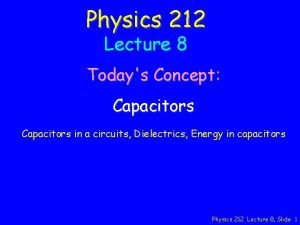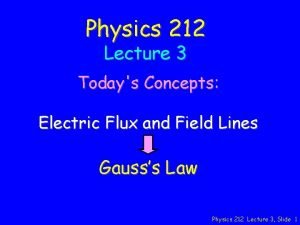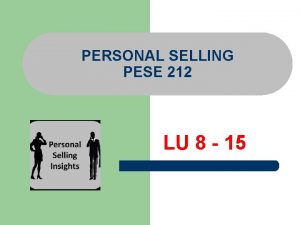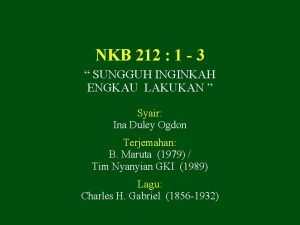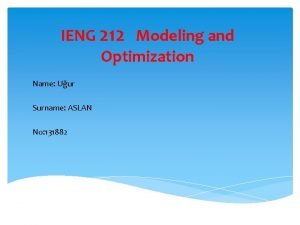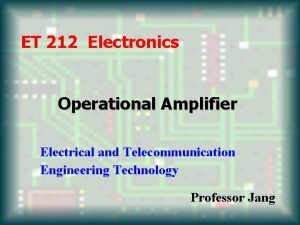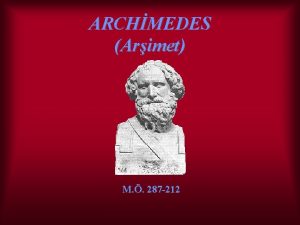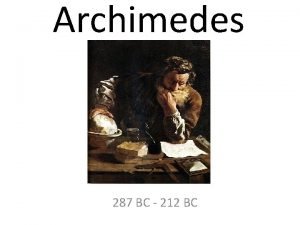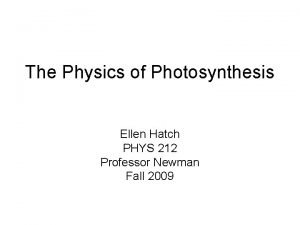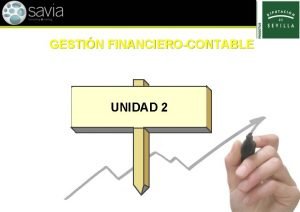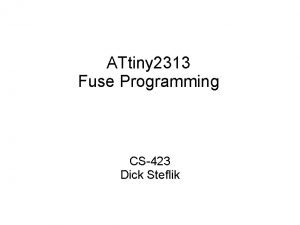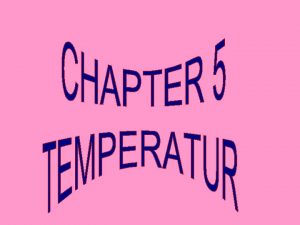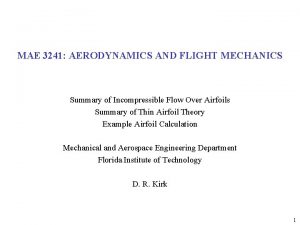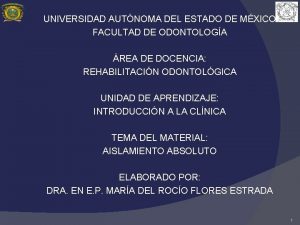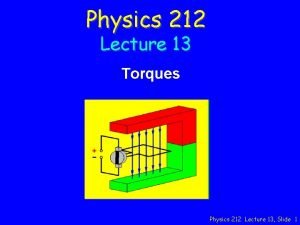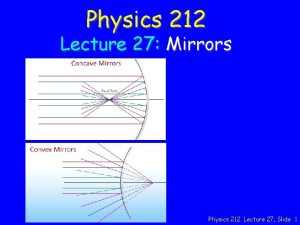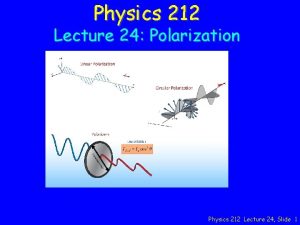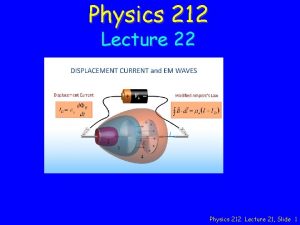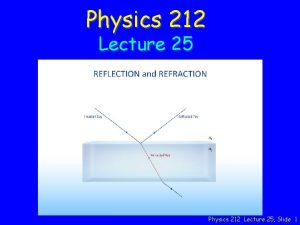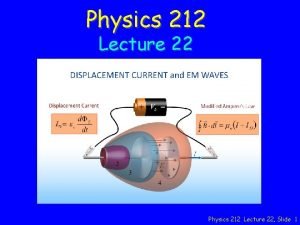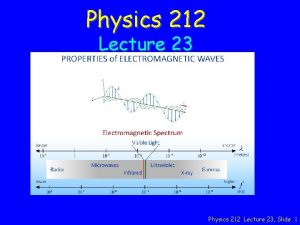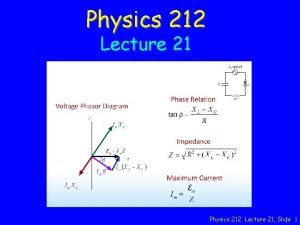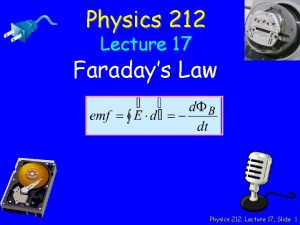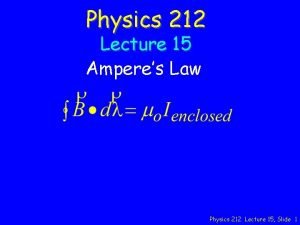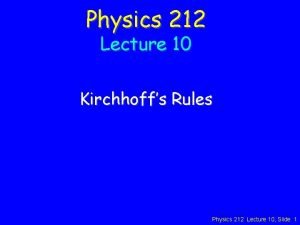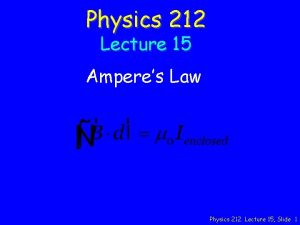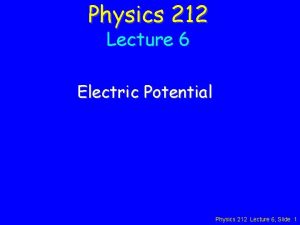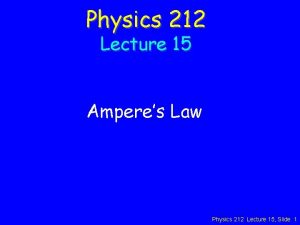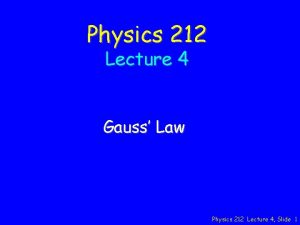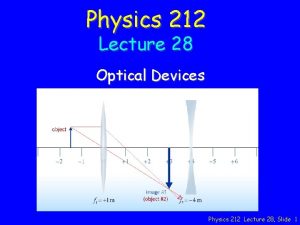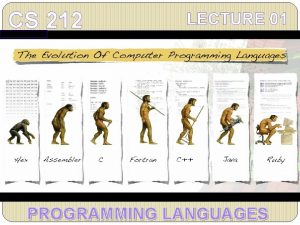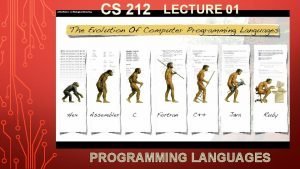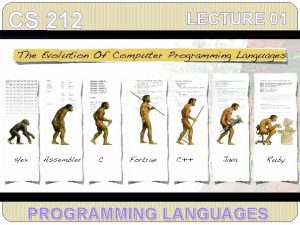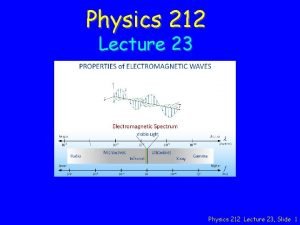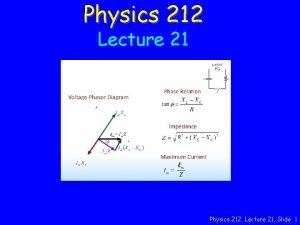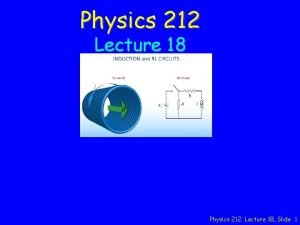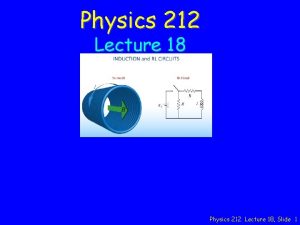Physics 212 Lecture 18 Slide 1 Main Point

























- Slides: 25

Physics 212 Lecture 18, Slide 1

Main Point 1 First, we defined the self-inductance L of a conducting loop to be the ratio of the magnetic flux through the loop to the current that produced it. This quantity is determined totally by the geometry of the loop. We used Faraday’s law to determine that the emf induced in the loop was equal to minus the product of the self-inductance with the time rate of change of the current. Physics 212 Lecture 18, Slide 2

Main Point 2 Second, we determined that the behavior of a simple RL circuit was identical in form to that of the corresponding RC circuit. In particular, we calculated the time constant for the RL circuit to be equal to the inductance divided by the resistance. Physics 212 Lecture 18, Slide 3

Main Point 3 Finally, we determined that the energy stored in an inductor is proportional to the product of the self-inductance and the square of the current flowing through it. This energy is stored in the magnetic field. We used a long solenoid to calculate the energy density in this magnetic field and found it was proportional to the square of the magnetic field, much like we found that the energy density in the electric field was proportional to the square of the electric field. Physics 212 Lecture 18, Slide 4

From the prelecture: Self Inductance Wrap a wire into a coil to make an “inductor”… e = -L d. I dt Physics 212 Lecture 18, Slide 5

Physics 212 Lecture 18, Slide 6

Checkpoint 1 Two solenoids are made with the same cross sectional area and total number of turns. Inductor B is twice as long as inductor A Compare the inductance of the two solenoids A) LA = 4 LB B) LA = 2 LB C) LA = LB D) LA = (1/2) LB E) LA = (1/4) LB Physics 212 Lecture 18, Slide 7

Physics 212 Lecture 18, Slide 8

Checkpoint 2 a In the circuit, the switch has been open for a long time, and the current is zero everywhere. At time t=0 the switch is closed. What is the current I through the vertical resistor immediately after the switch is closed? (+ is in the direction of the arrow) A) I = V/R B) I = V/2 R C) I = 0 D) I = -V/2 R E) I = -V/R Physics 212 Lecture 18, Slide 9

Checkpoint 2 b After a long time, the switch is opened, abruptly disconnecting the battery from the circuit. What is the current I through the vertical resistor immediately after the switch is opened? (+ is in the direction of the arrow) A) I = V/R B) I = V/2 R C) I = 0 D) I = -V/2 R E) I = -V/R Physics 212 Lecture 18, Slide 10

Physics 212 Lecture 18, Slide 11

Checkpoint 3 a After long time at 0, moved to 1 After long time at 0, moved to 2 After switch moved, which case has larger time constant? A) Case 1 B) Case 2 C) The same Physics 212 Lecture 18, Slide 12

Checkpoint 3 b After long time at 0, moved to 1 After long time at 0, moved to 2 Immediately after switch moved, in which case is the voltage across the inductor larger? A) Case 1 B) Case 2 C) The same Physics 212 Lecture 18, Slide 13

Physics 212 Lecture 18, Slide 14

Checkpoint 3 c After long time at 0, moved to 1 After long time at 0, moved to 2 After switch moved for finite time, in which case is the current through the inductor larger? A) Case 1 B) Case 2 C) The same Physics 212 Lecture 18, Slide 15

Physics 212 Lecture 18, Slide 16

How to think about RL circuits Episode 1: When no current is flowing initially: VL I=0 L t = L/R I=V/R R L R I VBATT At t = 0: VBATT t = L/R At t >> L/R: Physics 212 Lecture 18, Slide 17

RL Circuit (Long Time) What is the current I through the vertical resistor after the switch has been closed for a long time? (+ is in the direction of the arrow) A) I = V/R B) I = V/2 R C) I = 0 D) I = -V/2 R E) I = -V/R After a long time in any static circuit: VL = 0 - + + - KVR: VL + IR = 0 Physics 212 Lecture 18, Slide 18

Physics 212 Lecture 18, Slide 19

VBATT How to think about RL circuits Episode 2: When steady current is flowing initially: VL I=0 R L R I=V/R At t = 0: I = VBATT/R VR = IR VL = V R t = L/R At t >> L/R: I=0 VL = 0 VR = 0 Physics 212 Lecture 18, Slide 20

Physics 212 Lecture 18, Slide 21

Calculation The switch in the circuit shown has been open for a long time. At t = 0, the switch is closed. What is d. IL/dt, the time rate of change of the current through the inductor immediately after switch is closed R 1 V R 2 L R 3 Conceptual Analysis Strategic Analysis Physics 212 Lecture 18, Slide 22

Physics 212 Lecture 18, Slide 23

Physics 212 Lecture 18, Slide 24

Physics 212 Lecture 18, Slide 25
 Q=vc physics
Q=vc physics Physics 212 gradebook
Physics 212 gradebook Ano ang heel and toe polka
Ano ang heel and toe polka 01:640:244 lecture notes - lecture 15: plat, idah, farad
01:640:244 lecture notes - lecture 15: plat, idah, farad Classical mechanics
Classical mechanics Physics 101 lecture
Physics 101 lecture Physics 101 lecture 1
Physics 101 lecture 1 Physics 101 lecture notes pdf
Physics 101 lecture notes pdf Waves pdf
Waves pdf Atmospheric physics lecture notes
Atmospheric physics lecture notes Pese 212
Pese 212 Nkb 212
Nkb 212 Ienf-212
Ienf-212 Et 212
Et 212 Et 212
Et 212 Arm reach 212 cm on tiptoes
Arm reach 212 cm on tiptoes Archimedes ( arşimet) (mö 287–212 )
Archimedes ( arşimet) (mö 287–212 ) Archimedes last words
Archimedes last words Phys 212 equation sheet
Phys 212 equation sheet 212 instalaciones tecnicas ejemplos
212 instalaciones tecnicas ejemplos Attiny 212
Attiny 212 Có 3 thùng dầu mỗi thùng chứa 125l tóm tắt
Có 3 thùng dầu mỗi thùng chứa 125l tóm tắt Dalam suatu percobaan didapatkan grafik hubungan antara q
Dalam suatu percobaan didapatkan grafik hubungan antara q Naca 63-212
Naca 63-212 Arco de sauver
Arco de sauver Cls 212
Cls 212
